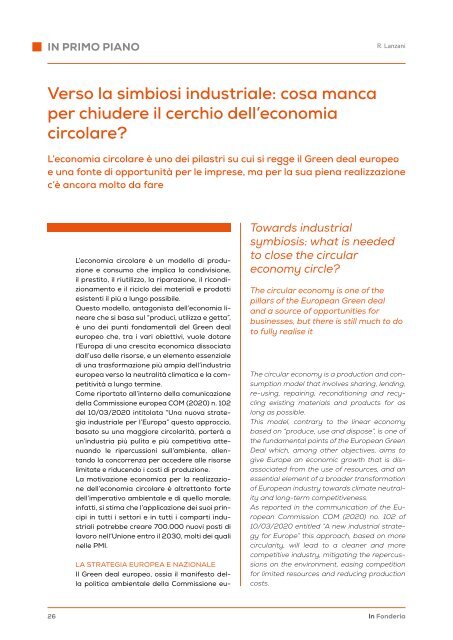In Fonderia 2 2024
Secondo numero del 2024 di In Fonderia
Secondo numero del 2024 di In Fonderia
You also want an ePaper? Increase the reach of your titles
YUMPU automatically turns print PDFs into web optimized ePapers that Google loves.
IN PRIMO PIANO<br />
R. Lanzani<br />
Verso la simbiosi industriale: cosa manca<br />
per chiudere il cerchio dell’economia<br />
circolare?<br />
L’economia circolare è uno dei pilastri su cui si regge il Green deal europeo<br />
e una fonte di opportunità per le imprese, ma per la sua piena realizzazione<br />
c’è ancora molto da fare<br />
L’economia circolare è un modello di produzione<br />
e consumo che implica la condivisione,<br />
il prestito, il riutilizzo, la riparazione, il ricondizionamento<br />
e il riciclo dei materiali e prodotti<br />
esistenti il più a lungo possibile.<br />
Questo modello, antagonista dell’economia lineare<br />
che si basa sul “produci, utilizza e getta”,<br />
è uno dei punti fondamentali del Green deal<br />
europeo che, tra i vari obiettivi, vuole dotare<br />
l’Europa di una crescita economica dissociata<br />
dall’uso delle risorse, e un elemento essenziale<br />
di una trasformazione più ampia dell’industria<br />
europea verso la neutralità climatica e la competitività<br />
a lungo termine.<br />
Come riportato all’interno della comunicazione<br />
della Commissione europea COM (2020) n. 102<br />
del 10/03/2020 intitolata “Una nuova strategia<br />
industriale per l’Europa” questo approccio,<br />
basato su una maggiore circolarità, porterà a<br />
un’industria più pulita e più competitiva attenuando<br />
le ripercussioni sull’ambiente, allentando<br />
la concorrenza per accedere alle risorse<br />
limitate e riducendo i costi di produzione.<br />
La motivazione economica per la realizzazione<br />
dell’economia circolare è altrettanto forte<br />
dell’imperativo ambientale e di quello morale;<br />
infatti, si stima che l’applicazione dei suoi principi<br />
in tutti i settori e in tutti i comparti industriali<br />
potrebbe creare 700.000 nuovi posti di<br />
lavoro nell’Unione entro il 2030, molti dei quali<br />
nelle PMI.<br />
LA STRATEGIA EUROPEA E NAZIONALE<br />
Il Green deal europeo, ossia il manifesto della<br />
politica ambientale della Commissione eu-<br />
Towards industrial<br />
symbiosis: what is needed<br />
to close the circular<br />
economy circle?<br />
The circular economy is one of the<br />
pillars of the European Green deal<br />
and a source of opportunities for<br />
businesses, but there is still much to do<br />
to fully realise it<br />
The circular economy is a production and consumption<br />
model that involves sharing, lending,<br />
re-using, repairing, reconditioning and recycling<br />
existing materials and products for as<br />
long as possible.<br />
This model, contrary to the linear economy<br />
based on “produce, use and dispose”, is one of<br />
the fundamental points of the European Green<br />
Deal which, among other objectives, aims to<br />
give Europe an economic growth that is disassociated<br />
from the use of resources, and an<br />
essential element of a broader transformation<br />
of European industry towards climate neutrality<br />
and long-term competitiveness.<br />
As reported in the communication of the European<br />
Commission COM (2020) no. 102 of<br />
10/03/2020 entitled “A new industrial strategy<br />
for Europe” this approach, based on more<br />
circularity, will lead to a cleaner and more<br />
competitive industry, mitigating the repercussions<br />
on the environment, easing competition<br />
for limited resources and reducing production<br />
costs.<br />
26<br />
<strong>In</strong> <strong>Fonderia</strong>














